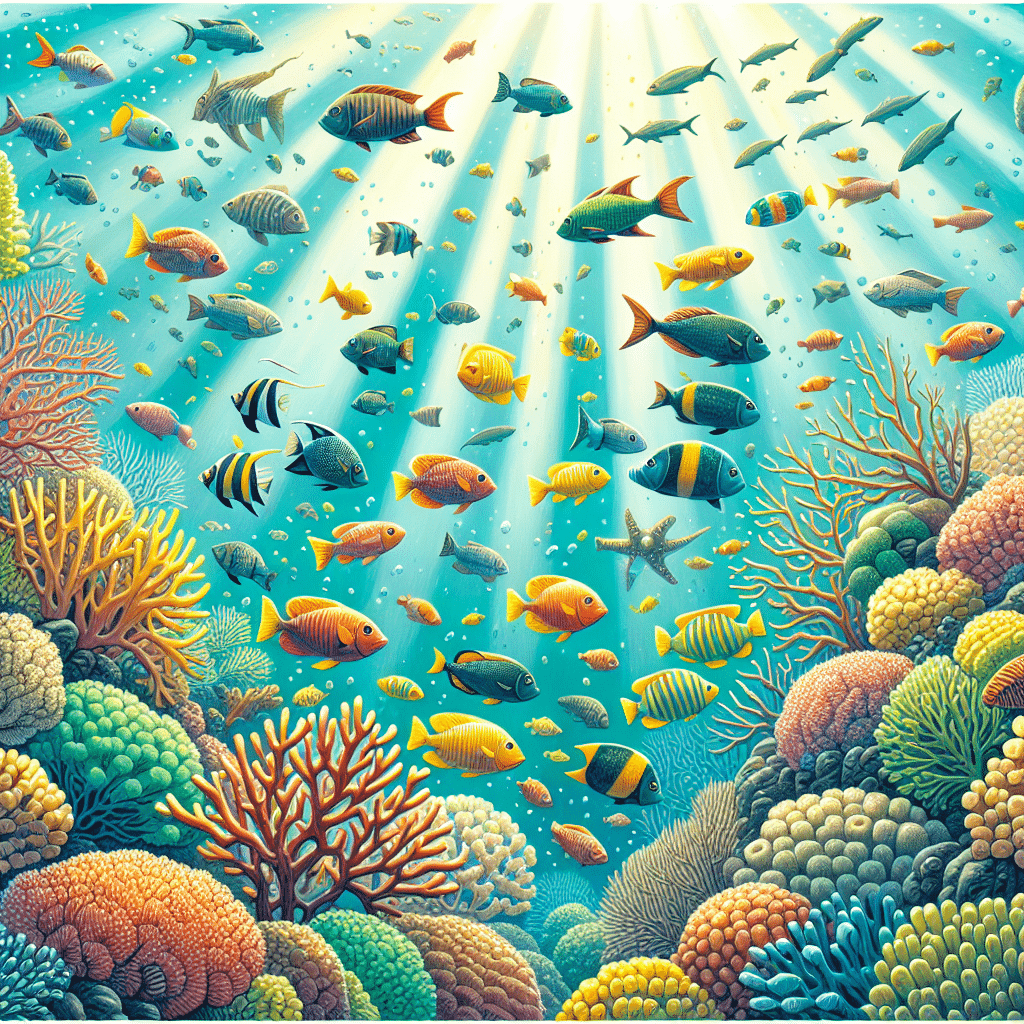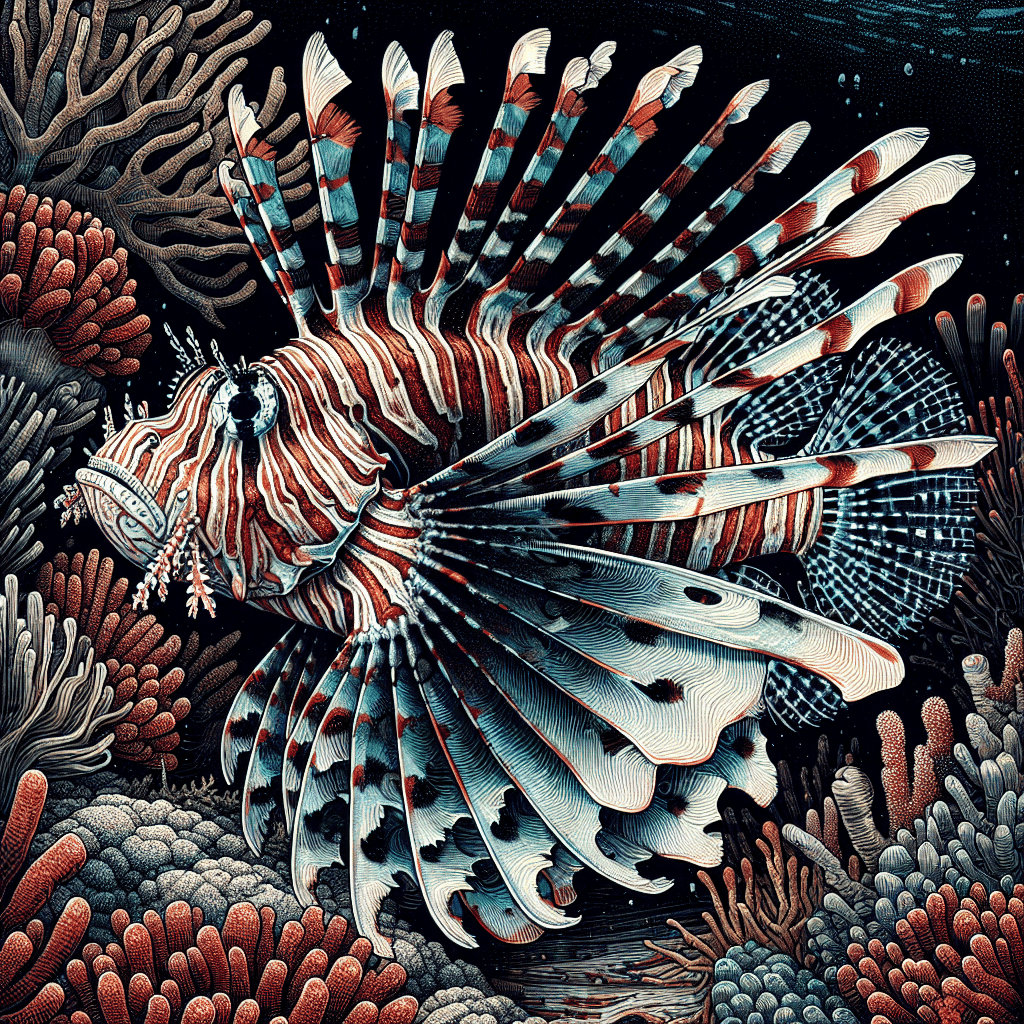All About Scorpionfish
Characteristics and Behavior
When I first learned about scorpionfish, I was fascinated by their unique appearance and behavior. These fish are known for their exceptional camouflage, allowing them to blend seamlessly into their surroundings. They typically have a mottled coloration that helps them hide among rocks and corals. Scorpionfish usually live alone and only come together during the mating season. During the day, they prefer to hide in caves, holes, or coral reefs, and some can even cover themselves in sand or mud. They are primarily nocturnal hunters, coming out at night to search for prey.
| Feature | Description |
|---|---|
| Average Length | 8 inches (up to 20 inches) |
| Habitat | Coral and rocky reefs |
| Behavior | Nocturnal, solitary |
Habitat and Distribution
Scorpionfish are primarily bottom-dwelling fish found in the Indian and South Pacific Oceans, particularly in temperate waters. They are commonly located in coral and rocky reefs, where they can easily hide from predators and ambush their prey. These fish can be found at various depths, sometimes residing as deep as 2,625 feet below the surface (Oceana).
| Location | Ocean |
|---|---|
| Indian Ocean | Yes |
| South Pacific | Yes |
| Depth Range | Up to 2,625 feet |
Understanding the characteristics and habitat of scorpionfish is essential for those of us interested in keeping them in a reef tank. Their unique adaptations and behaviors make them a fascinating species to observe. If you’re curious about other marine fish that might complement your aquarium, check out articles on lionfish and grouper for more information.
Feeding Habits of Scorpionfish
When it comes to keeping scorpionfish in an aquarium, understanding their feeding habits is key to ensuring they thrive. These fascinating fish have specific dietary preferences and unique feeding patterns that I’ve found essential to consider.
Dietary Preferences
Scorpionfish are opportunistic feeders, meaning they eat a variety of prey. Their diet primarily consists of small fish, crustaceans, snails, and even small cephalopods. In my experience, it’s crucial to provide a balanced diet that mimics their natural feeding habits. Here’s a quick overview of their dietary preferences:
| Food Type | Description |
|---|---|
| Small Fish | Live or frozen fish works well for them. |
| Crustaceans | Shrimp and crabs are great options. |
| Snails | They enjoy snails found in reef environments. |
| Cephalopods | Small octopuses or cuttlefish can be offered. |
While some scorpionfish may adapt to frozen food quickly, others tend to prefer live prey. I’ve found that feeding them live fish or shrimp can stimulate their hunting instincts, but it’s also important to offer a variety of options to keep them interested.
Feeding Patterns
Scorpionfish are primarily nocturnal hunters, which means they are most active at night. During the day, they often hide in crevices, relying on their incredible camouflage to ambush unsuspecting prey. It’s fascinating to watch how they blend into their surroundings, making them effective predators (Dressel Divers).
In terms of feeding frequency, it’s best to avoid overfeeding. I typically give my scorpionfish a substantial meal twice a week, ensuring the food is highly nutritious and varied. Here’s a simple feeding schedule to consider:
| Day | Feeding Activity |
|---|---|
| Monday | No feeding (rest day) |
| Tuesday | Large meal (live food) |
| Wednesday | No feeding (rest day) |
| Thursday | No feeding (rest day) |
| Friday | Large meal (frozen or live food) |
| Saturday | No feeding (rest day) |
| Sunday | No feeding (rest day) |
By following this schedule, I find my scorpionfish remain healthy and active. Ultimately, keeping an eye on their behavior and adjusting their diet as needed will help create a thriving environment in your reef tank. For more information on other marine species, check out our articles on lionfish and triggerfish.
The Venomous Nature of Scorpionfish
Scorpionfish are fascinating creatures, but their venomous nature makes them unique and potentially dangerous. Understanding their venomous spines and the precautions necessary for handling them is essential for any fish tank enthusiast.
Venomous Spines
Scorpionfish are equipped with venomous spines that can inject venom upon contact. Most of the venom is located on the spines of their dorsal fins, with some species also having venom in their ventral and anal fin spines (Dressel Divers). When these spines break through the skin, they can deliver a sting that is extremely painful to humans and potentially fatal to other animals (Oceana).
| Spine Location | Venom Presence | Potential Effects |
|---|---|---|
| Dorsal Fins | Yes | Painful sting, possible fatality to prey |
| Ventral Fins | Yes (some species) | Painful sting |
| Anal Fins | Yes (some species) | Painful sting |
It’s crucial for anyone interacting with these fish to be aware of their venomous capabilities. Even a minor touch can lead to significant discomfort.
Handling Precautions
When it comes to handling scorpionfish, caution is key. Here are some important precautions to take:
Wear Protective Gear: Always use gloves when handling scorpionfish to avoid direct contact with their spines.
Use Tools: If you need to move or catch a scorpionfish, use nets or specialized tools designed for safely interacting with venomous fish.
Avoid Prodding: Do not poke or prod the fish, as this increases the likelihood of a spine breaking through the skin.
Educate Others: If you’re in a shared aquarium space, make sure others are aware of the risks associated with scorpionfish.
Know the Symptoms: If stung, symptoms can include severe pain, swelling, and in some cases, more serious reactions. Seek medical attention if necessary.
By taking these precautions, I can safely enjoy the beauty of scorpionfish in my aquarium while minimizing risks. Always remember to respect their space and be mindful of their unique adaptations. For more information on other marine fish species, check out articles on lionfish, triggerfish, and pufferfish.
Species Diversity of Scorpionfish
Number of Species
I find the diversity of scorpionfish fascinating. There are 172 different species of scorpionfish, showcasing a wide range of adaptations and characteristics. Most of these species are less than two feet long, with some of the smallest being about the size of my pinky finger (Azul Unlimited). This variety makes them an interesting option for any aquarium enthusiast looking to add unique specimens to their reef tank.
| Species Count | Description |
|---|---|
| 172 | Total number of scorpionfish species |
| Size Range | Smallest about the size of a finger, largest up to 20 inches |
Size and Lifespan
Most scorpionfish tend to average around 8 inches in length, although some can grow up to 20 inches. They typically have a lifespan of about 15 years, making them a long-term commitment for any fish tank hobbyist. Female scorpionfish can release upwards of 15,000 eggs during spawning, which are then fertilized by males in the water. After hatching, the baby scorpionfish remain near the surface before eventually swimming down to the reefs.
| Size | Lifespan |
|---|---|
| Average Length | 8 inches |
| Maximum Length | 20 inches |
| Average Lifespan | 15 years |
Scorpionfish are not just unique in appearance; they also play an essential role in the marine ecosystem. If you’re curious about other fish species, check out our articles on marine fish, lionfish, and pufferfish for more insights into the fascinating world of reef tank inhabitants.
Reproduction in Scorpionfish
Reproductive Methods
Scorpionfish have some fascinating reproductive methods. Depending on the species, they can be either ovoviviparous or oviparous. Ovoviviparous species fertilize their eggs internally, and the female expels a gelatinous bag filled with fertilized eggs into the water. On the other hand, oviparous species involve a spawning process where females release eggs, which are then fertilized by males before they are incubated.
| Reproductive Method | Description |
|---|---|
| Ovoviviparous | Eggs are fertilized inside the female, and she releases a gelatinous bag of eggs. |
| Oviparous | Females spawn eggs that are fertilized by males and incubated. |
Offspring Development
The offspring of scorpionfish have a remarkable development process. Most species can produce a significant number of eggs, with females capable of releasing upwards of 15,000 eggs into the water for fertilization by males. After about two days, the eggs hatch, and the baby scorpionfish, known as larvae, remain near the surface to avoid predators. At this stage, they rely on plankton for nutrition until they grow large enough to swim down to the reefs (Oceana).
| Life Stage | Duration | Notes |
|---|---|---|
| Egg | 2 days | Eggs hatch into larvae. |
| Larval Stage | Varies | Remain near the surface, feeding on plankton. |
| Juvenile | Transition to reefs | Gradually become more independent and inhabit reef environments. |
This reproduction and development strategy helps ensure the survival of scorpionfish in their natural habitats. Understanding these methods can enhance my knowledge of caring for these unique fish in a marine tank.
Practical Care Tips for Scorpionfish
Taking care of scorpionfish in an aquarium can be a rewarding experience, but it does require some specific considerations. Here are some practical tips to ensure your scorpionfish thrive.
Substrate Requirements
Choosing the right substrate is essential for maintaining a healthy environment for scorpionfish. These fish prefer substrates that closely resemble their natural habitat. Some suitable options include:
| Substrate Type | Description |
|---|---|
| Coral Gravel | Mimics natural reef environments and provides a stable base. |
| Fine Sand | Allows for burrowing and is gentle on their bodies. |
It’s crucial to avoid sharp or rough substrates that could injure the fish. Additionally, when catching scorpionfish, be cautious as they can easily get caught in nets due to their unique body shape (Sea Dwelling Creatures).
Feeding Guidelines
Feeding scorpionfish can be quite interesting since they have a varied diet. They are opportunistic feeders and can eat anything that fits into their mouths, including prey that is nearly as long as they are. Here are some key points to consider:
- Diet: Scorpionfish enjoy a diet that includes small fish, crustaceans, and other meaty foods. Live foods are particularly enticing for them.
- Feeding Frequency: It’s best to feed adult scorpionfish 2-3 times a week, while juveniles may require daily feeding.
- Portion Size: Always monitor portion sizes to avoid overfeeding, which can lead to water quality issues.
| Food Type | Description |
|---|---|
| Live Fish | Provides natural hunting behavior; ensure they are suitable for your aquarium. |
| Frozen/Prepared Foods | Convenient option; look for high-quality marine fish diets. |
Be cautious when feeding scorpionfish, as they may also eat each other if there is a significant size difference.
Following these substrate and feeding guidelines will help create a suitable environment for your scorpionfish. For more information on other types of marine fish, check out our articles on lionfish and grouper.
Interesting Facts about Scorpionfish
Camouflage Abilities
One of the most fascinating aspects of scorpionfish is their incredible camouflage abilities. These fish have remarkable cryptic coloration and shape that make them nearly invisible against rocky backgrounds covered with marine organisms. Their body patterns and textures allow them to blend seamlessly into their environment, which is crucial for both predator avoidance and prey capture.
Scorpionfish are heavily camouflaged and often hide among mud, stones, or corals. This adaptive trait helps them confuse potential prey, such as animals that eat plants or coral, making it easier to ambush them. For instance, the Devil Scorpionfish, or Scorpaenopsis diabolus, can grow up to 25 centimeters long and has intricate patterns on its skin that mimic its surroundings, enhancing its stealth capabilities.
Predatory Techniques
Scorpionfish are ambush predators that rely on stealth and patience to capture their prey. Utilizing their camouflage, they blend into their surroundings and wait for unsuspecting small fish and crustaceans to swim by. Once the opportunity arises, they can rapidly inhale their prey, taking advantage of their well-disguised position.
This predatory technique is effective due to their ability to remain motionless for extended periods. They can strike with quick precision once they detect movement nearby. For anyone interested in observing these fascinating behaviors, having a well-planned aquarium setup that mimics their natural environment can enhance the viewing experience. If you’re curious about other marine fish that exhibit interesting behaviors, check out our sections on lionfish, triggerfish, and pufferfish.
Conservation Status of Scorpionfish
Threats and Challenges
Scorpionfish face various threats that impact their populations and habitats. Predators such as sharks, large snappers, and even humans pose significant risks. While scorpionfish have natural defenses, including venomous spines that deter many predators, they are still sought after in culinary dishes, which can lead to overfishing (Dressel Divers).
Additionally, habitat destruction, particularly in coral reefs where they reside, greatly affects their survival. These fish are typically found in warm waters near rocks and reefs, especially in the Indian and Pacific Oceans, as well as the Caribbean. Loss of habitat from pollution, climate change, and coral bleaching threatens their numbers and the biodiversity of the ecosystems they inhabit.
| Threats to Scorpionfish | Description |
|---|---|
| Predation | Sharks, rays, and large snappers |
| Overfishing | Targeted for culinary uses |
| Habitat Destruction | Coral reef degradation and pollution |
Conservation Efforts
Efforts are being made to protect scorpionfish and their habitats. Many regions implement fishing regulations to prevent overfishing and maintain sustainable populations. These regulations often include size limits and seasonal closures to allow fish to reproduce.
Marine protected areas (MPAs) are also established to safeguard scorpionfish habitats. These areas restrict human activity, helping to preserve the delicate ecosystems that support scorpionfish and other marine life.
Raising awareness about the ecological importance of scorpionfish can also contribute to conservation. Educating the public and fishing communities about the role these fish play in their ecosystems may help reduce overfishing and encourage sustainable practices.
For more information on marine fish conservation, check out the section on marine fish.



